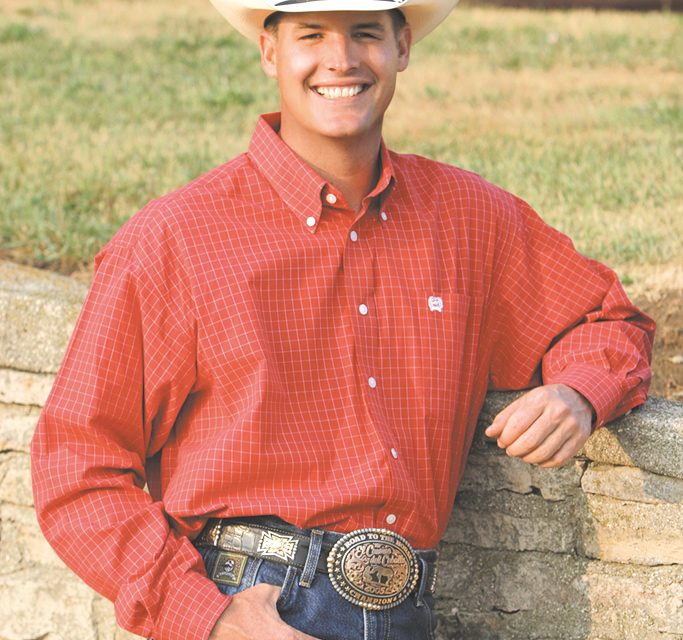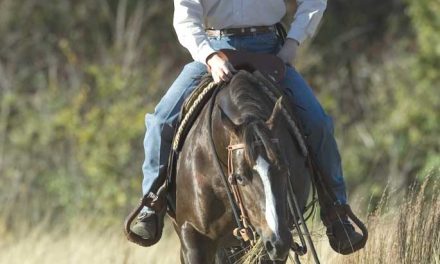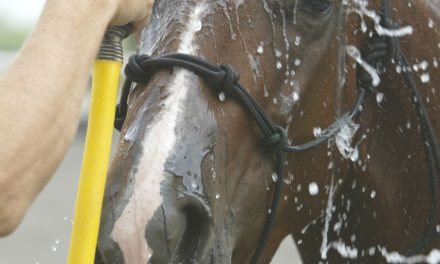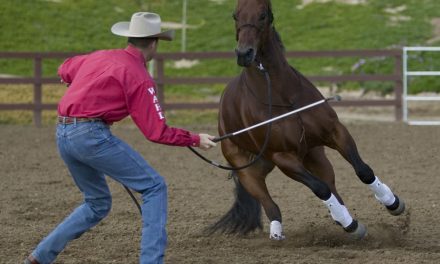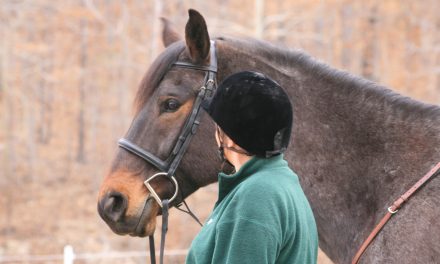If you compete in timed events with your horse, chances are you or someone you compete with has had to deal with an arena sour horse. A lot of people who compete in events like barrel racing or pole bending have arena sour horses.
Think about arena sourness from a horse’s perspective. Outside the arena, he gets to relax and hang out with his buddies. Inside the arena, he gets whipped and spurred to run fast. As soon as he leaves the arena he’s allowed to rest and be with his friends again. It’s no wonder these horses develop problems. I wouldn’t want to go in the arena either if every time I did I was whipped and spurred.
As soon as an arena sour horse is walked up the alleyway, he rears, spins around, and backs up — anything he can do to not go in the arena. When a horse is misbehaving, he uses the reactive side of his brain, not the thinking side. A horse will use the reactive side of his brain when he’s energetic and wants to go somewhere.
The more you try to make the horse behave, the more upset and nervous he gets. It’s a common reaction to grab onto the horse with two reins and try to make him stand still. In reality, grabbing onto both reins is the last thing you want to do to a misbehaving horse. Grabbing onto a horse with two reins makes him feel trapped and claustrophobic. A horse is a flight or fight animal — he either runs from danger or fights it. If he feels that he can’t move his feet, he’ll fight the danger. When a horse is using the reactive side of his brain you should only use one rein to control his feet, not two. So, remember: use one rein for softness and control, and two reins to get yourself killed.
In order for a horse to use the thinking side of his brain, move his feet forwards, backwards, left, and right. The more changes of direction you do and the more you make the horse move his feet, the more he’ll think and pay attention to you.
When you’re working with an arena sour horse, don’t think “How can I make this horse get in the arena?” Think, “How can I make it uncomfortable for the horse not to go in the arena?” I do that by working the horse hard whenever he wants to misbehave, and I do it in the exact place he wants to be. Then when he’s relaxed, I’ll take him into the arena and let him rest. I might even go into the arena and get off. I do the complete opposite of what the horse is expecting.
If the horse wants to be 110 feet away from the arena, then that’s where I work him. When I work him, I work him hard and make him hustle his feet, but I only use one rein to direct him. I do a lot of serpentines by bending the horse with my left hand and left leg, or if I want to go the opposite way, my right hand and right leg. I do lots of changes of direction. The more you change directions, the more he’ll use the thinking side of his brain.
On a nervous horse, one rein gets the horse soft and supple and two reins make him stiff. Serpentines are great exercises because the horse has to constantly move his feet and change directions. Rollbacks are good exercises also because the horse has to use his hindquarters and collect himself. The hindquarters are the horse’s gas pedal; the more control you have of the gas pedal, the more control you have of the horse. When you’re doing a rollback, canter the horse off, bring him to a stop, and roll him over his hocks.
It doesn’t really matter what you make the horse do as long as you make him hustle his feet. You can trot or canter circles, it doesn’t matter. The horse wants to be moving, so either do something constructive with his energy, or he’ll do something destructive with it. This exercise is pointless if you let the horse drag his feet and daydream about his next meal. Make him hustle his feet and give him a reason to want to go in the arena and relax.
Work the horse for 15 or 20 minutes away from the arena. Then take him into the arena and let him rest. In the beginning, you might only be able to bring the horse within 90 feet of the arena. When the horse is resting, rub him and give him a chance to catch his breath. Take advantage of the time and do one rein flexes. Concentrate on getting him soft and supple. I let the horse rest a good ten minutes before I go back to working him 110 feet away from the arena for another 15 or 20 minutes.
I want you to notice that every time I work the horse, I take him back to the original spot I started from. This is the place he wants to be: the barn, with a buddy, at a gate, and so on. In this example, that spot is 110 feet away from the arena. Every time I let the horse rest, I bring him closer to the arena. The second time I might get him 60 feet from the arena and the third time I might get him in the arena.
When you let the horse relax, dare him to move. Give him the reins, drape them down his neck. Don’t sit on him like a closed pocket knife, not moving a muscle. If the horse wants to move let him. Take him back to where you were working him and hustle his feet again. Instead of sitting on the horse saying “Don’t go, don’t go,” let him move, and then offer him the chance to stand still and relax. Give the horse a reason to want to go in the arena and be relaxed.
Once you get the horse in the arena, do the opposite of what he expects. The horse thinks that as soon as he steps one hoof in the arena he’s going to have to run like crazy. Instead, once you get in the arena, let him relax and get off of him. Put him in the barn and take the saddle off.
If you’re not smart, you’ll get the horse in the arena and run him. Then you’ll have to start the whole process over again.
Some horses are real smart about this and are only arena sour at horse shows. With a horse like that, take him to a few schooling shows and fool him. Make him think that you’re at the show to run for the money, but in reality, you’re just there to school him. Go through the same steps I described above. Work the horse away from the arena where he wants to be, and let him rest inside the arena. You might have to pay the entry fee and take the horse to the first barrel and stop and get off. Do whatever it takes to get the anxiety out of your horse. If you do that four or five shows in a row, your horse won’t anticipate the run as much. You might get several good runs out of him before he gets arena sour again. If or when that happens, you’ll have to take him back to the schooling shows to calm his anxiety again.
One of the most important things to keep in mind when you’re training a horse is that consistency is your greatest ally, and inconsistency is your greatest enemy. Doing this exercise one day isn’t going to cure an arena sour horse. In one day you can get him to relax inside of the arena, but you’re not going to cure him forever. However, if you consistently chip away at your horse’s fear and resentment of going into the arena, you will eventually be able to eliminate this problem.
Through his widely-popular Downunder Horsemanship program, Clinton Anderson works hard to educate horse owners on how to be safe and effective while enjoying their horses. His training methods are easy to understand and are designed to help horse owners get the results they desire. Clinton holds clinics and can be seen on RFD-TV. This Australian native is a two-time champion of the rigorous Road to the Horse Colt Starting Challenge, which gives trainers just three hours to break an unstarted colt. Learn more at www.downunderhorsemanship.com.

